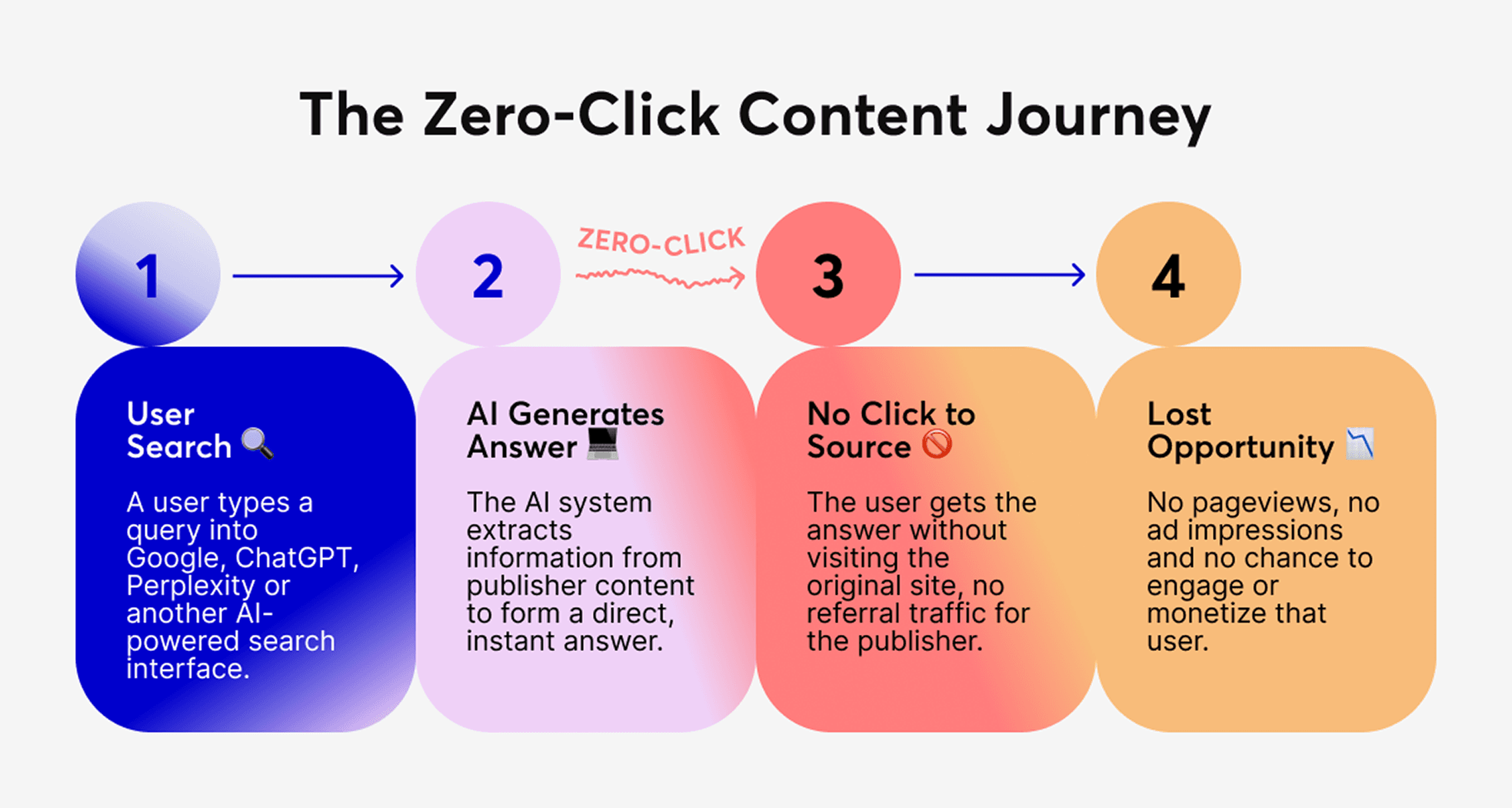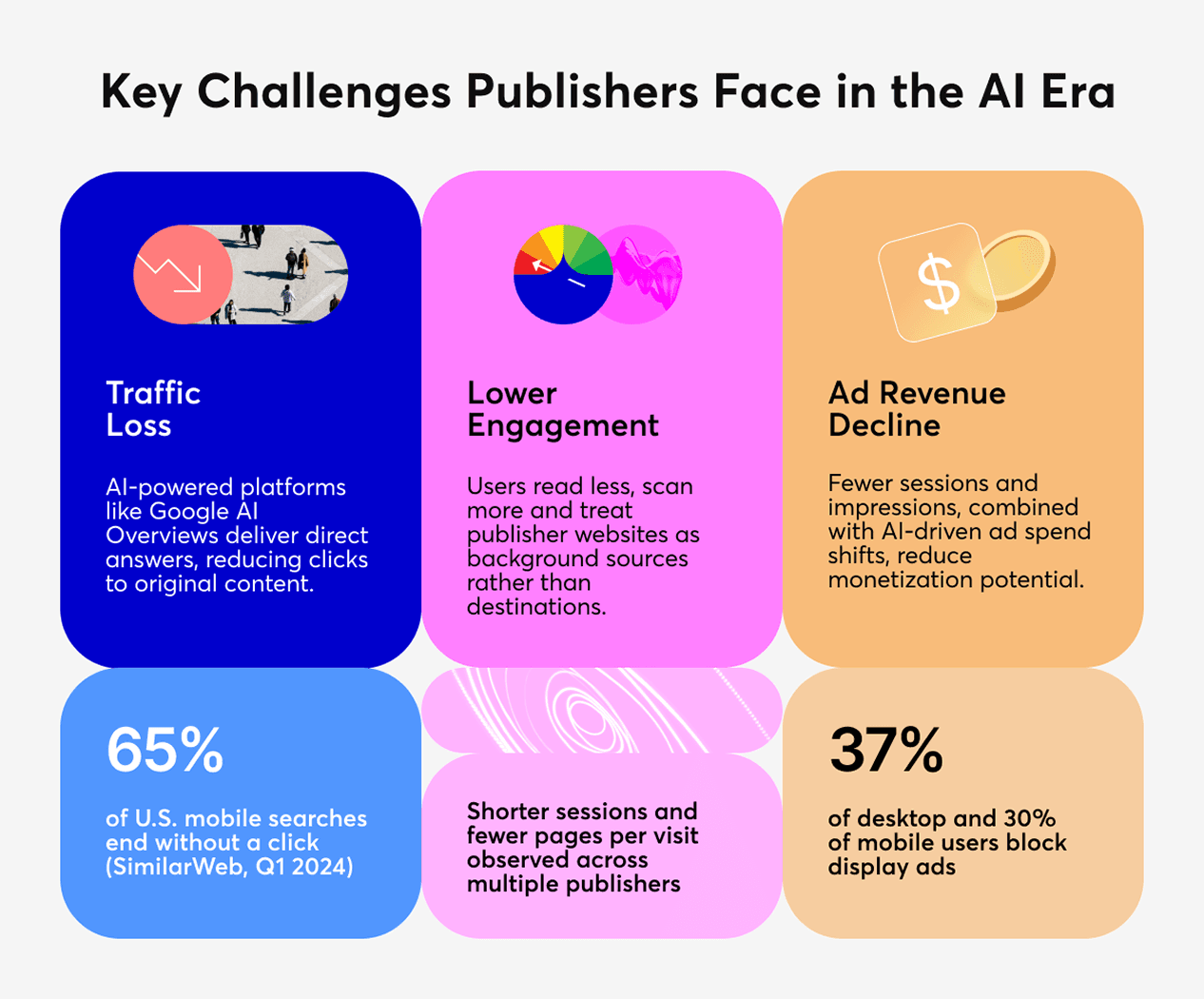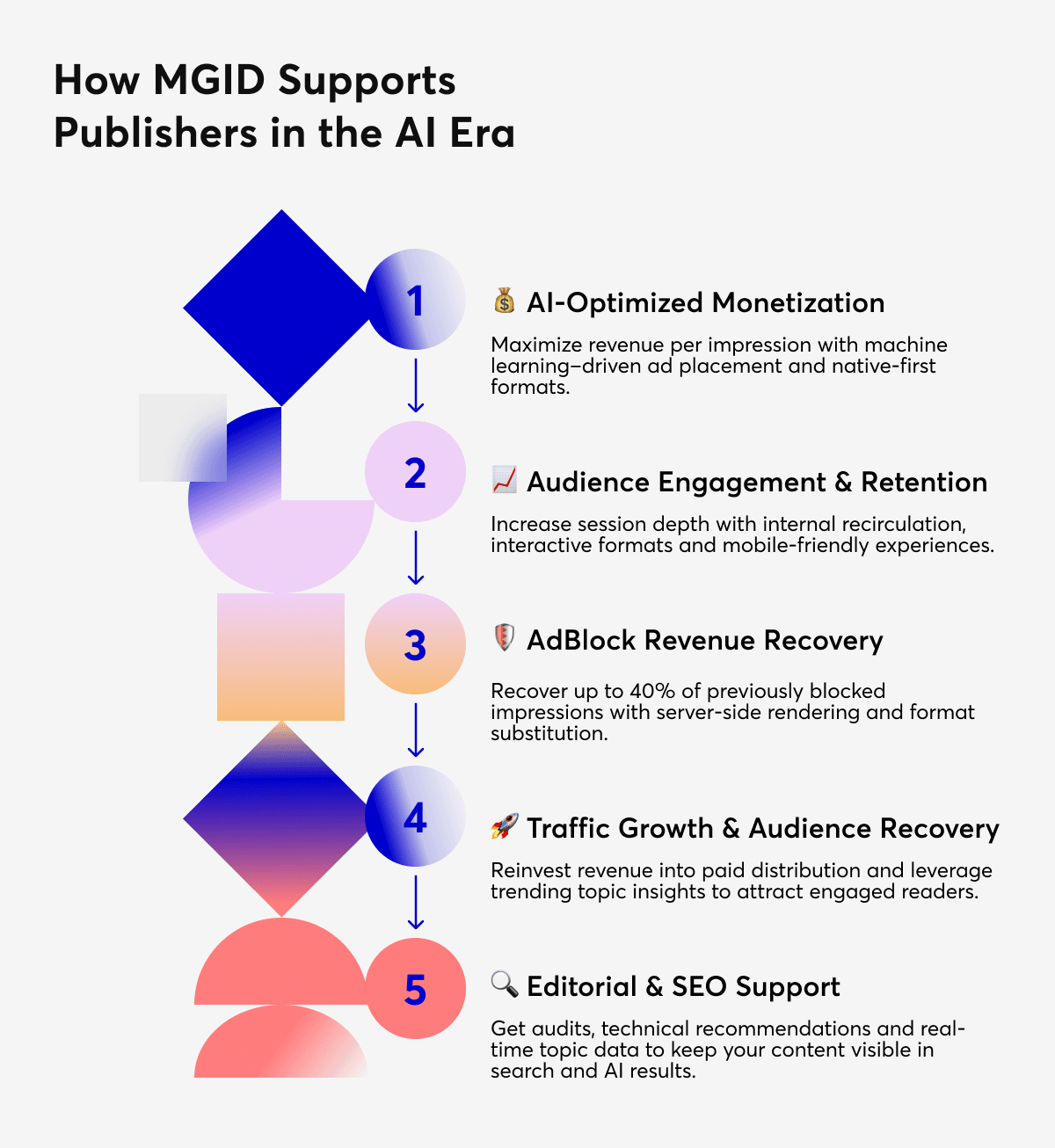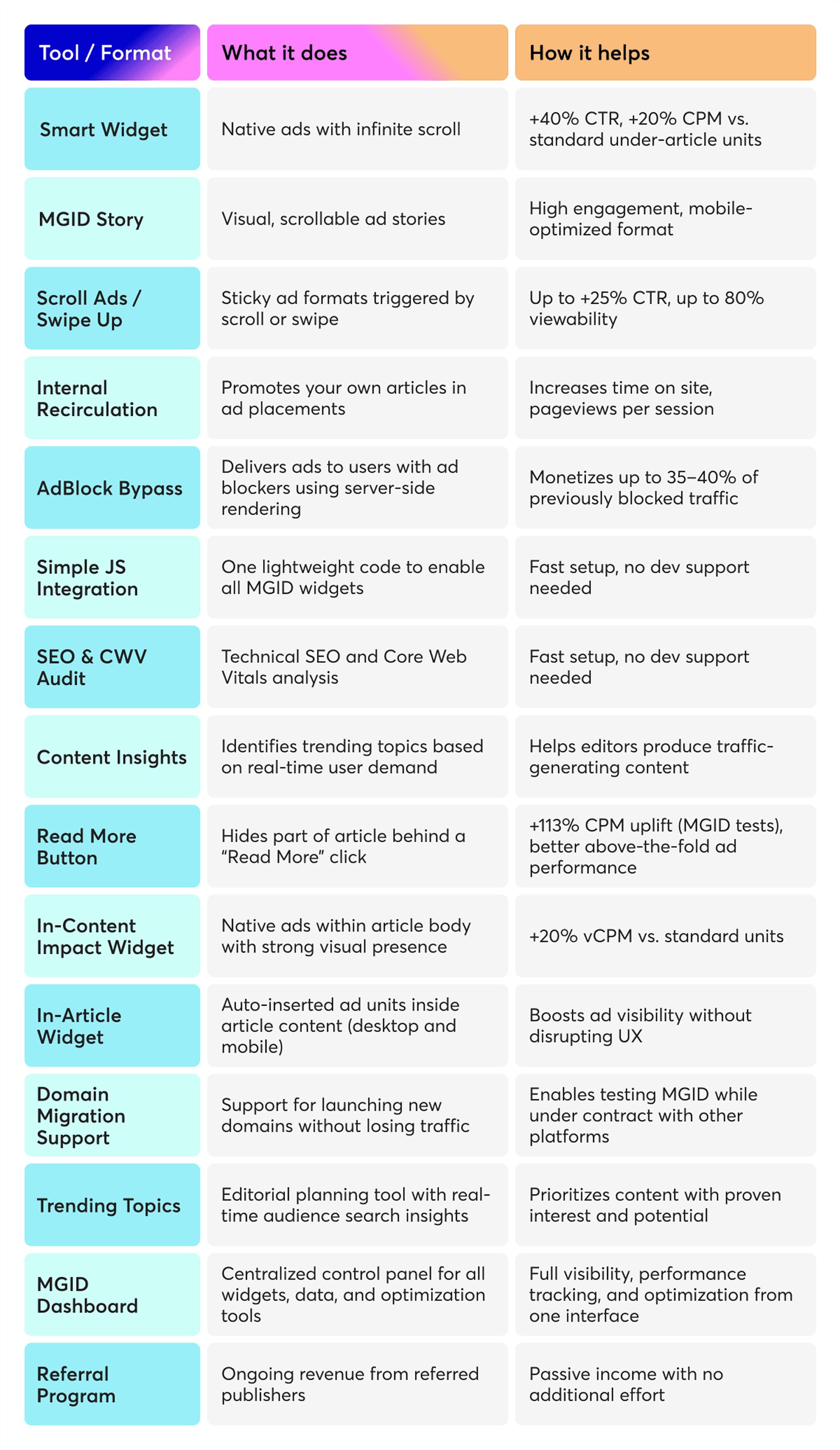AI is everywhere now. It writes, answers questions, summarizes content and even helps us plan our vacations or meals. In advertising, it is no different. Advertisers are using AI to personalize messages, optimize bidding in real time, boost ROI and fight ad fraud more efficiently than ever. Publishers are getting smarter too; for example, The New York Times used AI to personalize its content and managed to add 210,000 digital subscribers in just one quarter, increasing operating profit by 41% year-over-year.
However, not everything has been sunshine and growth charts. For many publishers, especially mid-sized ones, AI has also stirred up some serious trouble. Traffic is dropping, users are engaging less and ad revenues are getting squeezed. Tools like ChatGPT or Perplexity are pulling answers directly from sites without giving credit or clicks. Additionally, when people get what they need instantly, they’re less likely to dive into full articles or stick around.
In this guide, we’ll take a closer look at the challenges AI has brought to publishers, explore realistic strategies to adapt and explain how MGID can help you stay relevant, monetize better and even grow in this new AI-driven landscape.
Ready? Scroll down to start reading!
Table of contents
Click on any chapter to scroll directly to it.
Chapter 1
Why Publishers Are Losing Traffic, Engagement & Revenue
The growth of AI-powered platforms is changing how people search for and consume content. Interfaces like Google AI Overviews, ChatGPT and Perplexity now deliver direct answers, cutting traditional publishers out of the process entirely.
As user behavior shifts, publishers face growing pressure in three core areas.
- Traffic – AI tools reduce the need to click through to original sources.
- Engagement – Audiences read less, scan more and rely on AI to summarize.
- Revenue – With fewer sessions and impressions, advertising-based monetization suffers.
Below is a detailed breakdown of these challenges.
1. Organic Traffic Decline
AI systems increasingly extract and deliver answers directly from publisher content, leading to “zero-click” experiences.

Key trends:
- Google AI Overviews often cite content without linking back.
- Perplexity AI aggregates publisher content to form its own responses.
- ChatGPT, through web browsing tools, extracts insights from articles without driving visits.
Impact:
- Lower organic search traffic
- Declining referral traffic from platforms using LLMs as UI layers
- Diminishing visibility of original content in search results
Key statistic: According to SimilarWeb, in the first quarter of 2024, more than 65% of mobile searches ended without a click in the U.S.
2. Drop in User Engagement
AI interfaces train audiences to expect immediate answers.

Observed behavior shifts:
- Decrease in average session duration
- Fewer pages per visit
- Users increasingly treat publisher websites as background sources, not destinations
Even when users land on an article, many are skimming for confirmation or a quote, not reading deeply. Editorial features like long-form content, timelines and context layers are becoming underutilized.
3. Ad Revenue Compression
Traffic decline and reduced engagement directly impact monetization, but automation in ad tech compounds the issue.
Monetization headwinds:
- AI-driven bid optimization (e.g., in Google Ads) shifts more spend to lower-CPM placements.
- Publishers have less control over formats or prioritization.
- Performance-focused advertisers reduce spend on general display inventory.
Additionally:
- AdBlock usage continues to rise, cutting off revenue from a significant share of users.
- Cookie deprecation weakens targeting and retargeting, lowering CPMs.
Key statistic: Up to 37% of desktop users and 30% of mobile users now block display ads.

Bonus Risk: Content is Used Without Attribution or Value Return
While the immediate effects of AI show up in analytics dashboards, a long-term issue is developing behind the scenes: your content is training the very systems that replace your visibility.
What’s happening:
- AI models use publisher content to generate answers but do not guarantee attribution or compensation.
- LLM-based tools often paraphrase or summarize content without linking to the source.
- Legal action has begun (e.g., The New York Times vs. OpenAI, 2024), but the regulatory environment remains unclear.
Overall, the risk breaks down to ownership of value. Mid-tier publishers risk becoming invisible infrastructure for AI platforms unless new frameworks emerge.
In summary, AI is disrupting every stage of the traditional publishing funnel, from visibility to revenue. However, this shift isn’t irreversible. In the next section, we’ll discuss how publishers can adapt strategically, maintain resilience and unlock new opportunities within this AI-driven ecosystem.
Chapter 2
Adaptation Strategies for Mid-Tier Publishers
AI is changing the publishing game, but, unfortunately, not all publishers are equally equipped to respond. For mid-tier operations, those without massive technical teams or proprietary platforms, success lies in practical adaptation.
Below are eight practical, realistic strategies publishers can start implementing now.
1. Prioritize High E-E-A-T Content
Google and AI models prioritize content that demonstrates Experience, Expertise, Authoritativeness and Trustworthiness (E-E-A-T).
What to do:
- Include author names, bios and credentials on all editorial content.
- Add first-hand insights, real data or unique case studies, not just rewrites.
- Include quoted experts, and ideally link to their profiles or related work.
- Ensure content is fact-checked and updated regularly.
Practical idea: Rework general-topic articles (e.g. “How To Eat Healthier”) into content that includes personal experience, expert interviews or test-based results. This improves credibility and makes it harder for AI to fully replace the content.
2. Create Content for Humans, Not Just Algorithms
AI content can be factual, but often lacks nuance, voice and perspective. That’s your advantage.
Tactics:
- Use narrative formats: Q&A, first-person essays, behind-the-scenes stories.
- Address local issues, cultural contexts or user-specific problems.
- Encourage editors and journalists to include personal opinions, judgment and emotion.
- Invite readers into the process through comments, polls or feedback blocks.
Practical idea: Publish regular opinion or editorial columns with bylined commentary. AI tools struggle to replicate editorial tone, judgment and human bias, especially when tied to a specific voice or personality.
3. Build Distribution Channels Outside of SEO
Relying solely on Google search traffic is no longer sustainable. Publishers need to diversify their content discovery channels.
Steps to take:
- Launch a weekly or daily newsletter to deliver curated articles, editor insights and direct calls-to-action straight to readers’ inboxes.
- Build a WhatsApp Channel or Instagram Broadcast Channel to push article drops, live updates and exclusive behind-the-scenes content.
- Use web push notifications to instantly alert returning visitors about new or trending content in real time, especially if SEO is weak.
- Optimize content for shareability on niche platforms like Reddit, LinkedIn and Discord to spark targeted discussions and shares.
Practical idea: If SEO traffic drops, use messaging platforms or direct subscriptions to maintain visibility. This works especially well for verticals like education, personal finance or niche B2B content.
4. Diversify Revenue Streams with Hybrid Monetization
With display ad revenue under pressure, publishers need to build additional revenue streams, ideally from more engaged users.
Monetization options to explore:
- Add a “Support Us” block with membership tiers (Patreon, Ko-fi, Buy Me a Coffee).
- Implement micropayments using systems like Stripe’s Pay-per-view or Axate.
- Sell exclusive content packs, guides or templates.
- Offer editorial-as-a-service to brands that want to produce content under your byline.
Practical example: Publishers covering how-to content, personal development or professional education can package existing articles into downloadable resources. These can be offered as paid extras or gated lead magnets.
5. Integrate AI Tools Internally, but With Purpose
Use AI not to replace your team, but to enhance their capabilities and create better user-facing experiences.
Editorial use cases:
- Use GPT-based tools to generate article briefs, summaries and outlines.
- Auto-tag and categorize content for internal linking.
- Surface related articles dynamically to boost recirculation.
User-facing applications:
- “TL;DR” buttons that generate instant summaries
- On-page AI chat assistants trained on your archive
- Smart filter/search tools for large content libraries
Practical example: Integrate GPT-based tools to assist editors with initial research or topic outlines, freeing up time for reporting and editing instead of rote production work.
6. Refresh Evergreen Content to Stay Competitive
Some of your best-performing legacy content may now be answerable by AI assistants. Rather than abandoning it, update and reposition it.
Update strategy:
- Audit pages that dropped in traffic despite stable search volume.
- Reoptimize for today’s queries: focus on intent, freshness and actionability.
- Add additional commentary or updated sections.
- Repackage into formats AI can’t easily summarize (e.g. annotated lists, data tools).
Practical example: Turn generic evergreen posts into evolving content assets. For example, add a “2025 update” block or real-life use cases to improve uniqueness and topical relevance.
7. Make Content AI-Friendly with Structured Markup
If AI tools are going to surface and summarize your content, make sure they do it accurately and with attribution.
Implementation checklist:
- Use Schema.org tags for FAQ, HowTo, Article, Author and Product types.
- Add Open Graph and Twitter Card tags for better citation formatting.
- Maintain consistent headings, metadata and paragraph structure.
- Include source links to your own relevant content (internal linking).
Practical example: Review your top-performing content and implement structured data on all of it. Even basic markup like “Author” and “FAQ” can increase your chances of being cited in AI-generated results.
8. Partner with Similar Publishers for Cross-Growth
There is strength in numbers. In fact, mid-tier publishers can benefit from content and traffic partnerships with peers.
Collaboration ideas:
- Run shared content initiatives (e.g., The 2025 Outlook series co-published across 3 sites).
- Exchange guest posts and backlinks with publishers in your niche.
- Launch a joint newsletter or curated content hub.
- Co-invest in custom research or expert interviews to raise E-E-A-T across sites.
Practical example: If your site covers a narrow niche (e.g., legal tech, sustainable fashion, small business), find 2–3 similar publishers and create a shared editorial theme, guide or seasonal campaign. This improves authority and discoverability for all participants.

Bonus Strategy: Long-Term Thinking for AI-Era Publishers
While tactical fixes are important, long-term resilience comes from changing how publishing is framed. Mid-tier publishers should begin treating their content and brand as products with value beyond the article page.
Content as a Product
Move from one-off articles to modular, recurring or packaged formats:
- Create content series, thematic hubs or learning paths.
- Offer micro-academies, multi-part explainers or structured knowledge guides.
- Use modular design to enable republishing, remixing or bundling.
Instead of “publishing a post,” you’re building a resource center that can live across channels, allowing your content to and be cited, subscribed to or even monetized.
Brand as a Voice
What sets your site apart isn’t just your topics, but your tone, authors and perspective.
- Make authors visible and consistent: people remember names, not logos.
- Develop editorial personas, opinion columns or recurring contributors.
- Let your team be part of the story. They should be visible, authentic and relatable.
Readers don’t return to anonymous articles. They return to voices they trust. Editorial identity is your best defense against commoditization.
Distribution as an Interface
AI has become the new entry point to content, but you still control how your content is accessed and understood.
- Provide structured content feeds or APIs for syndication and referencing.
- Build partnership-ready documentation so AI tools can index and quote properly.
- Create content hubs that act as reliable sources for thematic information.
If AI is going to reference your domain, make sure it does so through your official structure, not someone else’s scraped version.
In summary, adapting to AI doesn’t require reinventing your entire operation, but it does require making focused, tactical changes. By prioritizing expert-led content, diversifying distribution, rethinking monetization and using AI as a tool (not a threat), mid-tier publishers can stay relevant and build resilience.
Chapter 3
From Strategy to Execution: How MGID Helps Publishers Grow with AI
Strategy is only as good as its implementation. To adapt to AI-driven changes in content consumption and monetization, publishers need tools that are fast to deploy, revenue-focused and SEO-safe.
That’s where MGID comes in. Unlike general ad platforms, MGID is purpose-built to support editorial publishers. It offers a full suite of solutions, monetization, traffic growth, SEO tools and engagement formats, tailored to the real challenges publishers face today.
Let’s break down how MGID directly supports the adaptation strategies covered in the previous section.

Monetization in the New Reality: Native Ads + AI Optimization
Challenge
Reduced traffic and changing user behavior mean fewer ad impressions and lower overall revenue. At the same time, automated systems like Google Ads may prioritize cost-efficiency over publisher-side yield.
How MGID helps:
- AI-driven placement optimization: MGID uses machine learning to automatically adjust ad placements and formats in real time, based on user behavior, content layout and device type. This allows each impression to generate the highest possible revenue.
- Native-first ad formats: Unlike traditional banners, MGID’s ad formats are designed for performance. They blend with content environments and deliver high engagement and CTR.
- Complementary to Google Ads: MGID works seamlessly alongside Google AdSense and MCM. This means you can diversify revenue sources without violating policies or hurting SEO visibility.
- SEO and Core Web Vitals safe: All MGID formats are optimized for fast loading, minimal layout shift and clean HTML structure, ensuring they don’t harm SEO or user experience.
- Quick, single-line integration: MGID’s Simple JS Integration allows you to launch all formats from a single lightweight script, no dev team required.
Why it matters in the AI era:
As more queries are resolved by AI tools (e.g., Google Overviews, ChatGPT), publishers see fewer clicks and fewer ad opportunities. This makes yield per impression more critical than ever. AI optimization ensures every ad slot delivers maximum revenue, even as traffic volume fluctuates.
Recommendation: Use Smart Widget as your primary monetization unit. With infinite scroll and dynamic loading, it typically increases CTR by up to 40% and CPM by 20% compared to standard under-article placements.
Audience Engagement & Retention
Challenge
With AI summarizing content and zero-click answers dominating search, users are reading less and spending less time on publisher websites. Scroll depth, pageviews per session and return visits are dropping, directly affecting both ad performance and brand loyalty.
How MGID helps:
- Internal Recirculation: MGID enables internal content promotion through its recommendation widgets. Your own articles appear in native-style content blocks, encouraging users to click deeper into your site and discover related content.
- "Read More" Button: This UX enhancement displays only the article introduction by default and prompts users to click Read More to continue. This shifts attention to ad placements earlier in the session, improving above-the-fold engagement and increasing ad viewability (+113% CPM increase on average, according to MGID platform tests).
- Engagement-optimized ad formats: Formats like MGID Story and Scroll Ads are designed to fit naturally into the content flow, maintaining user attention while maximizing ad exposure. These are ideal for mobile-first audiences and long-scroll environments.
Why it matters in the AI era:
AI interfaces may surface your headline or summary, but publishers must still earn the user's time. Increasing session depth helps train both users and algorithms to recognize the value of your domain. Better engagement metrics also support SEO signals and advertiser interest.
Recommendation: Combine Internal Recirculation with the Read More Button to increase time on site, boost CTR and improve revenue per session, especially on mobile.
AdBlock Revenue Recovery
Challenge
A significant portion of users, especially on desktop, are using ad blockers, which leads to invisible losses. Even if your content is getting traffic, 25–45% of sessions may be completely unmonetized, depending on your region and audience segment.
How MGID helps:
- AdBlock Bypass technology: MGID detects when users are running ad blockers and dynamically serves ads using non-standard delivery paths and server-side rendering, bypassing common filters.
- Format substitution: Blocked ad placements are automatically replaced with native, sponsored or alternative ad formats that are less likely to be suppressed.
- User-friendly prompts: MGID also offers opt-in prompts that encourage users to whitelist your site or accept ad delivery in exchange for access to content.
Why it matters in the AI era:
Publishers are already under pressure from lower overall traffic. Losing 30–40% of impressions to AdBlock further weakens monetization. As more users shift toward privacy-first browsing, recovering hidden revenue becomes crucial for sustainability.
Recommendation: Enable AdBlock Monetization across all traffic segments. It allows you to recover up to 40% of previously blocked impressions, turning invisible users into revenue without degrading experience.
Traffic Growth & Audience Recovery
Challenge
AI-generated summaries and changing search interfaces reduce organic traffic volumes. Mid-sized publishers, in particular, are vulnerable to this shift, losing discovery opportunities without having strong alternative traffic sources or paid acquisition budgets.
How MGID helps:
- Free paid traffic for new publishers: MGID offers new partners access to high-quality paid traffic at no cost during onboarding. This provides a soft landing if your SEO visibility or referral traffic has dropped.
- Revenue reinvestment into traffic: Publishers can reinvest a portion of their MGID revenue to purchase targeted traffic directly within the MGID platform, helping drive engaged users back to high-performing pages.
- Content consulting and topic insights: MGID supports content teams with guidance on what to publish next, based on real-time search interest. This allows editorial teams to align content strategy with high-demand topics that drive traffic.
Why it matters in the AI era:
As AI platforms become the first stop for information, publishers must proactively drive users to their sites via multiple sources, not rely on search alone. Having access to paid distribution levels the playing field with larger media brands, and understanding which content themes are trending ensures you compete for attention at the topic level.
Recommendation: Use MGID’s traffic reinvestment model to amplify visibility of key evergreen content and test paid promotion, especially for landing pages, hubs and newsletter signups.
Editorial & SEO Support
Challenge
AI is reshaping how content is ranked, cited and surfaced. Publishers not only need to write quality content, but structure it correctly, update it regularly and align it with evolving search and AI indexing requirements. For many mid-tier teams, this stretches editorial capacity.
How MGID helps:
- SEO & Core Web Vitals audits: MGID provides detailed audits of your website’s technical SEO health, including loading speed, layout shifts and performance benchmarks. Recommendations are tailored to ensure your site remains AI- and search-engine-friendly.
- Trending Topics Tool: This tool helps publishers identify what users are currently searching for across the MGID network and beyond. It’s a data-driven input for editorial planning, ideal for capturing timely traffic and building clusters of high-interest content.
- Content strategy support: MGID’s account managers offer consultations on editorial direction, including article format, topic focus, headline structure and schema markup best practices.
Why it matters in the AI era:
AI models increasingly prefer structured, factual and high-E-E-A-T content, and often use it without sending traffic back. Well-structured markup and content clusters increase the chance of being cited by AI tools with attribution. With regular updates and strategic publishing, you can protect your ranking in both search engines and LLM-powered assistants.
Recommendation: Use MGID’s SEO audit and topic insight tools to maintain technical performance and guide your content team toward topics with verified user interest.
Bonus: MGID Products and Formats That Support Publishers
Below is a summary of MGID’s core tools and ad formats that directly help publishers adapt to the challenges of the AI-driven landscape. Whether it’s recovering revenue, increasing engagement or simplifying operations, each tool is designed to deliver measurable value.

This toolkit allows publishers to maximize every impression, regain lost revenue and build stronger user engagement, all while staying technically compliant and SEO-optimized. MGID's modular approach ensures you can start simple and scale over time.
In summary, MGID provides publishers with a practical, flexible toolkit to respond to AI-driven disruption without the need for major structural overhauls. Through AI-optimized monetization, user engagement tools, traffic support and editorial guidance, MGID helps mid-tier publishers turn strategic adaptation into measurable growth.
Chapter 4
Final Note: It's Not the End of Publishing, It's the Beginning of Reinvention
The rise of AI may feel like a threat, but in reality it’s a powerful filter. It challenges publishers to refocus on what truly matters: quality, voice, structure, strategy and staying power.
Those who adapt will stand out. Those who resist will fade into the feed.
MGID offers more than monetization tools: it offers a bridge between traditional publishing and the demands of an AI-powered web. With tech that respects SEO, formats designed for real engagement and support tailored to mid-sized publishers, MGID is a real growth partner.
The future is about working smarter, building stronger and staying essential. MGID helps you do exactly that. Ready to future-proof your publishing business?
Let’s talk about how MGID can help you:
- Maximize revenue without compromising SEO;
- Re-engage your audience with smarter formats;
- Recover lost traffic and build new growth channels;
- Get expert support tailored to your editorial and business goals.
The future of publishing isn’t waiting. Why should you? Connect with MGID now and take the first step toward smarter monetization and stronger audience loyalty.





